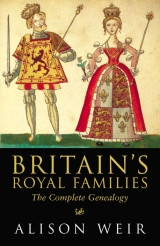
Текст книги "Britain's Royal Families"
Автор книги: Элисон Уир
Жанр:
Историческая проза
сообщить о нарушении
Текущая страница: 15 (всего у книги 21 страниц)

James II
FATHER: Charles I(  see here).
see here).
MOTHER: Henrietta Maria of France(  see here, under Charles I).
see here, under Charles I).
SIBLINGS: (  see here, under Charles I).
see here, under Charles I).
JAMES II
He was born on 14 (O.S.) or 24 (N.S.) October, 1633, at St James’s Palace, London, and was designated Duke of York from birth. He was made a Knight of the Garter on 20 April, 1642. He was created Duke of York on 27 January, 1644, and Earl of Ulster on 10 May, 1659. He was created Duke of Normandy by Louis XIV of France on 31 December, 1660. He succeeded his brother Charles II as King of Great Britain on 6 February, 1685. Having converted to Roman Catholicism sometime previously, he was privately crowned by Catholic rites on 22 April, 1685, at Whitehall Palace, London; he was crowned by the traditional Anglican ritual on 23 April, 1685, at Westminster Abbey.
James II married firstly, in secret in November or on 24 December, 1659, at Breda, Holland (although doubts exist as to whether this ceremony ever took place), and publicly on 3 September, 1660, at Worcester House, The Strand, London:
Anne
She was the daughter of Edward Hyde, 1st Earl of Clarendon, by Frances, daughter of Sir Thomas Aylesbury, and she was born on 12 or 22 March, 1637, at Cranbourne Lodge, Windsor. She died on 31 March, 1671, at St James’s Palace, London, of cancer, and was buried in Westminster Abbey.
Issue of marriage:
1 Charles
He was born on 22 October, 1660, at Worcester House, The Strand, London, and was designated Duke of Cambridge. He died on 5 May, 1661, at Whitehall Palace, London, and was buried in Westminster Abbey.
2 Mary II(  see here).
see here).
3 James
He was born on 11 or 12 July, 1663, at St James’s Palace, London. He was created Duke and Earl of Cambridge and Baron of Dauntsey, Wilts., on 23 August, 1664, and was made a Knight of the Garter on 3 December, 1666. He died on 20 June, 1667, at Richmond Palace, Surrey, and was buried in Westminster Abbey.
4 Queen Anne(  see here).
see here).
5 Charles
He was born on 4 July, 1666, at St James’s Palace, London, and was designated Duke of Kendal, Earl of Wigmore and Baron Holdenby; there is no evidence of any formal creation. He died on 22 May, 1667, at St James’s Palace, London, and was buried in Westminster Abbey.
6 Edgar
He was born on 14 September, 1667, at St James’s Palace, London. He was created Duke and Earl of Cambridge and Baron of Dauntsey, Wilts., on 7 October, 1667. He died on 8 June, 1671, at Richmond Palace, Surrey, and was buried in Westminster Abbey.
7 Henrietta
She was born on 13 January, 1669, at Whitehall Palace, London. She died on 15 November, 1669, at St James’s Palace, London, and was buried in Westminster Abbey.
8 Katherine
She was born on 9 February, 1671, probably at Whitehall Palace, London (less probably at Richmond Palace, Surrey). She died on 5 December, 1671, at St James’s Palace, London, and was buried in Westminster Abbey.
James II married secondly, by proxy on 20 (O.S.) or 30 (N.S.) September, 1673, at the Ducal Palace, Modena, Italy, and in person on 21 November, 1673, at Dover, Kent:
Mary Beatrice Eleanor Anne Margaret Isabella
Baptised Maria, but called Mary from the time of her marriage, she was the daughter of Alfonso d’Este III, Duke of Modena, by Laura, daughter of Girolamo Martinozzi, and she was born on 25 September (O.S.) or 5 October (N.S.), 1658, at the Ducal Palace, Modena, Italy. She was crowned Queen Consort by Catholic rites on 22 April, 1685, at Whitehall Palace, London, and by Anglican rites on 23 April, 1685, at Westminster Abbey. She died on 7/8 May, 1718, at the Château of St Germain-en-Laye, Paris, of cancer, and was buried in the Abbey of the Visitation of St Mary, Chaillot, France (although her body was later destroyed during the French Revolution).
Issue of marriage:
1 Stillborn child
It was born in March or May, 1674.
2 Katherine Laura
She was born on 10 January, 1675, at St James’s Palace, London. She died on 3 October, 1675, at St James’s Palace, London, of convulsions, and was buried in Westminster Abbey.
3 Stillborn child
It was born in October, 1675.
4 Isabella
She was born on 18 (O.S.) or 28 (N.S.) August, 1676, at St James’s Palace, London. She died on 2 or 4 March, 1681, at St James’s Palace, and was buried in Westminster Abbey.
5 Charles
He was born on 7 November, 1677, at St James’s Palace, London, and was designated Duke of Cambridge. He died on 12 December, 1677, at St James’s Palace, of smallpox, and was buried in Westminster Abbey.
6 Elizabeth
She was born and died in c.1678.
7 Stillborn child
It was born in February, 1681.
8 Charlotte Maria
She was born on 16 August, 1682, either at St James’s Palace, London, or at Windsor Castle. She died on 6 October, 1682, at St James’s Palace, of convulsions, and was buried in Westminster Abbey.
9 Stillborn child
It was born in October, 1683.
10 Stillborn child
It was born in May, 1684.
11 James Francis Edward
Called ‘James III’, according to Roman Catholic doctrine, he was also known as the ‘Chevalier de St George’ or ‘The Old Pretender’. He was born on 10 June, 1688, at St James’s Palace, London. There were widespread rumours at the time that he was a changeling, smuggled into the Queen’s bed in a warming pan, but this was mere political invention. What is certain is that the birth of a Catholic heir ensured that James II’s days as King were numbered. James was Duke of Cornwall and Rothesay from birth, and was styled Prince of Wales and Earl of Chester from birth. His father abdicated when he was a baby, and he spent his life in exile in France or Italy. He was made a Knight of the Garter in 1692. He succeeded his father as Stuart pretender to the throne of Great Britain (from which he was barred by the Act of Settlement) on 16 September, 1701, and was proclaimed in France as ‘James III of England and VIII of Scotland’. He was attainted by Act of Parliament on 2 March, 1702, and forfeited all his British titles. He died on 1 January, 1766, in Rome, where he was buried in St Peter’s Basilica in the Vatican.
James married, by proxy on 9 (O.S.) or 19 (N.S.) May, 1719, at Bologna, Italy, and in person on 1 or 3 September, 1719, at Montefiascone Cathedral, Italy:
Maria Casimire Clementina
She was the daughter of Prince James Louis Henry Sobieski of Poland, by Hedwig Elizabeth Amelia, daughter of Philip William, Elector of Pfalz-Neuburg, and she was born on 6 (O.S.) or 17/18 (N.S.) July, 1702. She was called ‘Queen of Great Britain’ by adherents of the Stuarts. She died on 12 or 18 January, 1735, at the Apostolic Palace, Rome, and was buried in St Peter’s Basilica in the Vatican.
Issue of marriage:
(i)
Charles Edward Louis John Philip Casimir Sylvester Maria
Called ‘Charles III’ by his adherents, he was also known as the ‘Chevalier de St George’, ‘The Young Pretender’ and ‘Bonnie Prince Charlie’. He was born on 31 December, 1720, at the Palazzo Muti, Rome, and was styled ‘Prince of Wales’ from birth. He sometimes styled himself ‘Count of Albany’. On the death of his father on 1 January, 1766, he succeeded him as Stuart pretender to the throne of Great Britain, styling himself ‘Charles III’. He died on 30/31 January, 1788, at the Palazzo Muti, Papazurri, Rome, and was buried in Frascati Cathedral, Italy. His remains were later removed to St Peter’s Basilica in the Vatican.
Charles had the following
illegitimate issue
:
By Clementina Maria Sophia Walkinshaw, Countess of Alberstroff (
d
.1802):
1 Charlotte, Countess of Albany in her own right (1753–1789). She had illegitimate issue.
Charles married, by proxy on 28 March, 1772, in Paris, and in person on 17 April, 1772, at the Chapel of the Palazzo Compagnani, Marefoschi, Macerata, Ancona, Italy:
Louise Maximiliana Caroline Emanuèle
She was the daughter of Gustavus Adolphus, Prince of Stolberg-Gedern, by Elizabeth Philippine Claudine, daughter of Maximilian Emanuel, Prince of Homes and of the Empire. She was born on 20 or 21 September, 1752, at Mons, Hainault, Flanders. After her marriage, she was styled ‘Queen of Great Britain’ by adherents of the Jacobite cause. It is possible, but not probable, that she made a second marriage, either with Count Vittorio Alfieri, or with Francis Xavier Fabre. She died on 29 January, 1824, at Florence, Italy, and was buried in the Church of Santa Croce, Florence.
(ii)
Henry Benedict Maria Clement Thomas Francis Xavier
He was born on 6 or 21 March, 1725, at the Palazzo Muti, Papazurri, Rome, Italy, and was styled ‘Duke of York’ from birth by adherents of the Jacobite cause. He entered the Roman Catholic Church, and was ordained Cardinal Deacon on 30 June, 1747, and Cardinal of Santa Maria, Portici, on 3 July, 1747, before being ordained as a priest on 1 September, 1748. He was known thereafter as ‘Cardinal York’. He was provided to the Archbishopric of Corinth on 19 November, 1758, but was translated to the Bishopric of Frascati, Italy, on 13 July, 1761. He succeeded his brother Charles as Pretender to the throne of Great Britain on 30/31 January, 1788, styling himself ‘Henry IX’. He died on 13 July, 1807, at Frascati, Italy, and was buried in St Peter’s Basilica in the Vatican, Rome, after being briefly laid to rest in the church of St Andrea della Valle, Rome.
12 Louisa Maria Theresa
She was baptised Louisa Maria, and received the name Theresa at her confirmation. She was born on 18 (O.S.) or 28 (N.S.) June, 1692, at the Château of St Germain-en-Laye, Paris, and died there on 8 (O.S.) or 18 (N.S.) April, 1712. She was buried in the Chapel of St Edmund in the Church of the English Benedictines, Rue St Jacques, Paris, but later transferred to St Germain-en-Laye by order of George IV.
James II also had the following illegitimate issue:
By Arabella (1648–1730), daughter of Sir Winston Churchill and sister of John Churchill, 1st Duke of Marlborough:
1 Henrietta FitzJames (1667–1730); she married firstly Henry, 1st Baron Waldegrave of Chewton, Somerset (1661–1690), and had issue. She married secondly Piers Butler, 2nd Viscount of Galmoye ( d.1740).
2 James FitzJames (1670–1734), Duke of Berwick; he married firstly Honora (1674–1697), daughter of William Bourke, Earl of Clanricarde, and had issue. He married secondly Anne ( d.1751), daughter of Henry Bulkely, and had issue.
3 Henry FitzJames, Duke of Albemarle (1673–1702); he married Marie Gabrielle (1675–1741), daughter of John d’Audibert, Count of Lussan, and had issue.
4 Arabella (1674–1704); she became a nun at Pontoise, France, under the name Ignatia.
Arabella Churchill may have borne James other children who died young prior to 1670.
By Katherine, Countess of Dorchester (1657–1717), daughter of Sir Charles Sedley:
5 Katherine Darnley (1679/81–1743); she married firstly James Annesley, Earl of Anglesey ( d.1702), but they later divorced. She married secondly John Sheffield, Duke of Buckingham and Normanby (1647–1721), and had issue.
6 James Darnley (1684–1685).
7 Charles Darnley ( d.young).
JAMES II
He was deemed by Parliament to have abdicated on 11 December, 1688, by fleeing the country to exile in France. He was formally deposed by Parliament on 23 December, 1688. He died on 16 September, 1701, at the Château of St Germain-en-Laye, near Paris. His body was temporarily buried in the Chapel of St Edmund in the Church of the English Benedictines in the Rue St Jacques, Paris, whilst hopefully awaiting eventual transportation to England for burial in Westminster Abbey. The body seems to have disappeared, however, during the French Revolution, although there are reports that it was found and reinterred at St Germain-en-Laye by order of George IV.
An Interregnum followed the deposition of James II, who was succeeded two months later by his son-in-law William of Orange and his daughter Mary as joint sovereigns.

William III and Mary II
WILLIAM III
FATHER: William( II)
He was the son of Frederick Henry, Prince of Orange, by Amalia, daughter of John Albert I, Count of Solms-Braunfels, and he was born on 27 May, 1626, at The Hague, Holland. He married Mary Stuart on 2 May, 1641, at the Chapel Royal, Whitehall Palace, London. He was made a Knight of the Garter on 2 March, 1645. He succeeded his father as William II, Stadtholder of the United Provinces of the Netherlands, in March, 1647. He died on 6 November, 1650, at the Binnenhof Palace at The Hague, of smallpox, and was buried at Delft, Holland.
MOTHER: Mary Henrietta
She was the daughter of Charles I, King of Great Britain, by Henrietta Maria of France, and she was born on 4 or 29 November, 1631, at St James’s Palace, London. She was designated Princess Royal in c.1642, thus establishing the tradition that the eldest daughter of a British sovereign bears the title Princess Royal. She died on 24 December, 1660, at Whitehall Palace, London, of smallpox, and was buried in Westminster Abbey.
SIBLINGS: William III did not have any siblings.
WILLIAM III
Baptised William Henry, he was born on 4 (O.S.) or 14 (N.S.) November, 1650, at the Binnenhof Palace, The Hague, Holland. He was Stadtholder of Holland from birth, his father having predeceased him, but was deprived of the title during his childhood. He was made a Knight of the Garter on 25 April, 1653. He was designated Count of Nassau-Dillenburg, and reinstated as Stadtholder of Holland in 1672. He acceded to the throne of Great Britain as joint sovereign with his wife Mary (the rightful heir) on 13 February, 1689, following the Interregnum after the abdication and deposition of his father-in-law James II. William was crowned on 11 April, 1689, at Westminster Abbey. He died on 8 March, 1702, at Kensington Palace, London, and was buried in Westminster Abbey.
William III married, on 4 November, 1677, either at St James’s Palace or at Whitehall Palace, London:
MARY II
FATHER: James II(  see here).
see here).
MOTHER: Anne Hyde (  see here, under James II).
see here, under James II).
SIBLINGS: (  see here, under James II).
see here, under James II).
MARY II
She was born on 30 April, 1662, at St James’s Palace, London. She was proclaimed Queen of Great Britain on 13 February, 1689, following the deposition of her father and the Interregnum; she reigned as joint sovereign with her husband, with whom she was crowned on 11 April, 1689. She died on 28 December, 1694, at Kensington Palace, London, of smallpox, and was buried in Westminster Abbey.
Issue of marriage:
1 Stillborn child
It was born in c.April, 1678, at Breda, Holland.
2 Stillborn child
It was born in September, 1678, at Hanserlaersdyck, Holland.
3 Stillborn child
It was born in February, 1680, at The Hague, Holland.
WILLIAM III
After Mary II’s death, William IIIreigned alone, the rightful heir, Anne Stuart, having given up her place in the succession to him for the term of his life.
William was succeeded by Anne in 1702.

Queen Anne
FATHER: James II(  see here).
see here).
MOTHER: Anne Hyde(  see here, under James II).
see here, under James II).
SIBLINGS: (  see here, under James II).
see here, under James II).
QUEEN ANNE
She was born on 6 February, 1665, at St James’s Palace, London. She succeeded her brother-in-law William III as Queen of Great Britain on 8 March, 1702, and was crowned on 23 April, 1702, at Westminster Abbey. In 1707, she adopted the royal style Queen of Great Britain, France and Scotland, following the Act of Union.
Queen Anne married, on 28 July, 1683, at the Chapel Royal, St James’s Palace, London:
George
He was the son of Frederick III of Oldenburg, King of Denmark, by Sophia Amelia, daughter of George, Duke of Brunswick-Lüneberg, and he was born on 2 April (date on coffin plate), 29 February, 11 November or 21 April, 1653, at Copenhagen, Denmark. He was naturalised as an English subject on 20 September, 1683, and made a Knight of the Garter on 1 January, 1684. He was created Duke of Cumberland, Earl of Kendal and Baron Wokingham (‘Ockingham’) on 6 April, 1689. During Queen Anne’s reign he was styled Prince George, never King Consort. He died on 28 October, 1708, at Kensington Palace, London, and was buried in Westminster Abbey.
Issue of marriage:
1 Stillborn daughter
She was born on 12 May, 1684, and was buried in Westminster Abbey.
2 Mary or Marie
She was born on 2 June, 1685, at Whitehall Palace, London. She died on 8 February, 1687, at Windsor Castle of ‘an acute infection’, and was buried in Westminster Abbey.
3 Anne Sophia
She was born on 12 May, 1686, at Windsor Castle. She died there on 2 February, 1687, and was buried in Westminster Abbey.
4 Stillborn child
It was born between 20 January and 4 February, 1687, probably on 21 January, and was buried in Westminster Abbey.
5 Stillborn son
He was born on 22 October, 1687, and was buried in Westminster Abbey on the day of his birth.
6 Miscarriage
It occurred on 16 April, 1688.
7 Stillborn child (?)
It was perhaps born late in 1688.
8 William Henry
He was born on 24 July, 1689, at Hampton Court Palace, and was styled Duke of Gloucester from birth, although he was never formally so created. He was made a Knight of the Garter on 6 January, 1695. He died on 30 July, 1700, at Windsor Castle, of hydrocephalus, and was buried in Westminster Abbey.
9 Mary
She was born on 14 October, 1690, at St James’s Palace, London, where she died, aged 2 hours, the same day. She was buried in Westminster Abbey.
10 George
He was born on 17 April, 1692, at Syon House, Brentford, Middlesex, where he died, aged a few minutes, the same day. He was buried in Westminster Abbey.
11 Stillborn daughter
She was born on 23 March, 1693, at Berkely House, St James’s Street, London, and was buried in Westminster Abbey.
12 Stillborn child
It was born on 21 January, 1694, and may have been a daughter.
13 Stillborn daughter
She was born on 17 or 18 February, 1695.
14 Stillborn son
Of six months’ growth, he was born on 25 March, 1696.
15 Stillborn twins
A male foetus of 2 or 3 months’ growth and a male foetus of 7 months’ growth were born on 25 March, 1697, and were buried in St George’s Chapel, Windsor.
16 Stillborn son
He was born in early December (before 10 December), 1697.
17 Stillborn son
He was born on 15 September, 1698, at Windsor Castle, and was buried in St George’s Chapel, Windsor.
18 Stillborn son
He was born on 25 January, 1700, and was buried in Westminster Abbey.
QUEEN ANNE
She died on 1 August, 1714, at Kensington Palace, London, and was buried in Westminster Abbey. Although she conceived 19 children, none survived her, and she was the last Stuart sovereign.
She was succeeded by her third cousin, Prince George of Hanover.
CHAPTER EIGHT
The House of Hanover
When Queen Anne died in 1714, her nearest living Protestant relative was her third cousin, Prince George of Hanover, who was the grandson of Elizabeth Stuart, the Winter Queen of Bohemia and daughter of James I; Elizabeth’s daughter Sophia had married the Elector of Hanover. When the Act of Settlement was passed in 1701, investing the succession in the House of Hanover, Sophia was still alive and hopeful of becoming Queen of Great Britain herself in the fullness of time; this was not to be, as she died only weeks before Queen Anne passed away, and it was her son George who succeeded instead.
There were, however, still living in France at that time, members of the House of Stuart, the children of James II, notably Prince James Francis Edward, the Old Pretender (as he later came to be called). He was a Roman Catholic, and therefore barred from the succession, yet he maintained all his life the belief that he was the rightful King of Great Britain, and his adherents, known as Jacobites, led an uprising on his behalf in 1715 in an ill-fated attempt to restore him to the throne. It failed miserably, and James never took up arms again in his cause. It was left to his son, known to history as Bonnie Prince Charlie, to uphold the Jacobite claims, and in 1745 a further uprising saw the young Prince at first victorious. The bloody defeat of his supporters at Culloden, however, put an end once and for all to any hopes the Stuarts had of ever regaining the throne. In exile in Italy, they quietly continued to style themselves Kings of Great Britain: James III, Charles III, and lastly Henry IX (brother of Charles), but they were no longer a threat to the House of Hanover, and their line came to an end in 1807.
The Hanoverians reigned over Great Britain for nearly 200 years, with the succession passing peacefully from father to son, or grandson, and, finally, to the girl who became the illustrious Queen Victoria. Yet the sovereigns of this particular dynasty all manifested a peculiar resentment against their heirs designate: George I, George II and George III all disliked their eldest sons vehemently; George IV had a poor relationship with his only daughter, Princess Charlotte; and Queen Victoria never understood and was irritated by the future Edward VII. It was not, on a personal level, a happy dynasty.
Furthermore although it was a fruitful dynasty, it was fraught with marital scandals. George I divorced his wife for adultery, and shut her up in a castle for the rest of her life. Several brothers and sons of George III made morganatic, or unofficial, and therefore unsuitable, marriages, most notably the future George IV. Some Hanoverian males lived openly in sin with their mistresses, many for years. It was the marriages of his brothers that shocked George III, a moral-minded man, into passing the Royal Marriages Act in 1772. This Act, which still applies to the royal family today, provides that any marriage made by any of the descendants of George II without the consent of the sovereign automatically becomes null and void. Should the sovereign withhold consent to a projected marriage, the Prince or Princess wishing to make it may wait until he or she reaches the age of 25 and then apply to the Privy Council for assent. This being given, the marriage may be lawfully entered into. It will be seen in the following chapters what effect the Act had upon the personal lives of members of the House of Hanover.
Modern monarchy evolved during the Hanoverian period. Increasingly, the sovereign reigned, rather than ruled, over his/her people. The rights of the sovereign became confined to the rights of being informed, of advising, and of warning those in whom actual power was invested, i.e. the government.
The monarch came to be seen more as a figurehead than as a participant; George II was the last king to lead his troops into battle, at Dettington in 1747. Later sovereigns confined their martial activities to reviewing their armed forces, and undertaking military training. As Head of the Church of England, the monarch was expected to set a moral example. Few of the Hanoverians were capable of this. It was left to George III and Queen Charlotte, Queen Adelaide, and Queen Victoria and Prince Albert to set moral standards acceptable to their people, and which we now think of as Victorian. In this way, the monarchy became very much a domestic institution, and to this day a constitutional sovereign leading an exemplary family life has a very much better chance of achieving popularity than one who might be described as ‘playboy’. One is reminded, when reflecting upon this, of the Victorian lady who went to watch a performance of Shakespeare’s Antony and Cleopatra:‘So unlike the home life of our own dear Queen!’ she commented.
The Hanoverians were very much a German dynasty; even Queen Victoria spoke with a German accent. They married German princes or princesses. Apart from George IV and Victoria, they had little time for the arts, although George I and George II patronised Handel. They were not popular monarchs, and suffered scathing portrayals by the caricaturists of their time. They were licentious and uncouth; even Victoria was highly sexed, and in her youth revelled in being ‘decadent’. George I and George II saw Britain as secondary in importance to Hanover, which did not endear them to their new subjects. Yet this dynasty, which began so unpromisingly with George I, ended in a blaze of glory as Victoria, the Queen-Empress, celebrated her Diamond Jubilee four years before her death in 1901, amidst scenes of unprecedented adulation and reverence. Thus was the monarchy pulled from the mire to the pinnacle of respectability where it has remained, almost constantly, to this very day.








